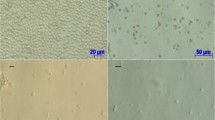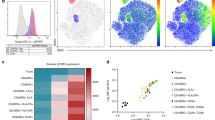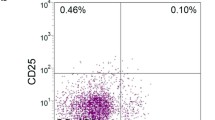Abstract
CD4+CD25+ regulatory T cells (Treg), if properly expanded from umbilical cord blood (UCB), may provide a promising immunotherapeutic tool. Our previous data demonstrated that UCB CD4+CD25+ T cells with 4-day stimulation have comparable phenotypes and suppressive function to that of adult peripheral blood (APB) CD4+CD25+ T cells. We further examined whether 2-week culture would achieve higher expansion levels of Tregs. UCB CD4+CD25+ T cells and their APB counterparts were stimulated with anti-CD3/anti-CD28 in the presence of IL-2 or IL-15 for 2 weeks. The cell proliferation and forkhead box P3 (FoxP3) expression were examined. The function of the expanded cells was then investigated by suppressive assay. IL-21 was applied to study whether it counteracts the function of UCB and APB CD4+CD25+ T cells. The results indicate that UCB CD4+CD25+ T cells expanded much better than their APB counterparts. IL-2 was superior to expand UCB and APB Tregs for 2 weeks than IL-15. FoxP3 expression which peaked on Day 10–14 was comparable. Most importantly, expanded UCB Tregs showed greater suppressive function in allogeneic mixed lymphocyte reaction. The addition of IL-21, however, counteracted the suppressive function of expanded UCB and APB Tregs. The results support using UCB as a source of Treg cells.




Similar content being viewed by others
References
Sakaguchi S, Sakaguchi N, Shimizu J, et al. Immunologic tolerance maintained by CD25+CD4+ regulatory T cells: their common role in controlling autoimmunity, tumor immunity, and transplantation tolerance. Immunol Rev. 2011;182(1):18–32.
Sakaguchi S. Naturally arising CD4+ regulatory T cells for immunologic self-tolerance and negative control of immune responses. Annu Rev Immunol. 2004;22:531–62.
Hoffmann P, Ermann J, Edinger M, Fathman CG, Strober S. Donor-type CD4+CD25+ regulatory T cells suppress lethal acute graft-versus-host disease after allogeneic bone marrow transplantation. J Exp Med. 2002;196(3):389–99.
Taylor PA, Lees CJ, Blazar BR. The infusion of ex vivo activated and expanded CD4+CD25+ immune regulatory cells inhibits graft-versus-host disease lethality. Blood. 2002;99(10):3493–9.
June CH, Blazar BR. Clinical application of expanded CD4+25+ cells. Semin Immunol. 2006;18(2):78–88.
Godfrey WR, Spoden DJ, Ge YG, et al. Cord blood CD4+CD25+-derived T regulatory cell lines express FoxP3 protein and manifest potent suppressor function. Blood. 2005;105(2):750–8.
Takahata Y, Nomura A, Takada H, et al. CD4+CD25+ T cells in human cord blood: an immunoregulatory subset with naive phenotype and specific expression of forkhead box p3 (Foxp3) gene. Exp Hematol. 2004;32(7):622–9.
Brown JA, Boussiotis VA. Umbilical cord blood transplantation: basic biology and clinical challenges to immune reconstitution. Clin Immunol. 2008;127(3):286–97.
Lin SJ, Yan DC, Lee YC, Hsiao HS, Lee PT, Liang YW, Kuo ML. Umbilical cord blood immunology: relevance to stem cell transplantation. Clin Rev Allergy Immunol. 2012;42(1):45–57.
Brunstein CG, Miller JS, Cao Q, et al. Infusion of ex vivo expanded T regulatory cells in adults transplanted with umbilical cord blood: safety profile and detection kinetics. Blood. 2011;117(3):1061–70.
Zorn E, Mohseni M, Kim H, et al. Combined CD4+ donor lymphocyte infusion and low-dose recombinant IL-2 expand FOXP3+ regulatory T cells following allogeneic hematopoietic stem cell transplantation. Biol Blood Marrow Transplant. 2009;15(3):382–8.
Carson WE, Giri JG, Lindemann MJ, et al. Interleukin (IL) 15 is a novel cytokine that activates human natural killer cells via components of the IL-2 receptor. J Exp Med. 1994;180(4):1395–403.
Imamichi H, Sereti I, Lane HC. IL-15 acts as a potent inducer of CD4+CD25hi cells expressing FOXP3. Eur J Immunol. 2008;38(6):1621–30.
Yates J, Rovis F, Mitchell P, et al. The maintenance of human CD4+ CD25+ regulatory T cell function: IL-2, IL-4, IL-7 and IL-15 preserve optimal suppressive potency in vitro. Int Immunol. 2007;19(6):785–99.
Lee CC, Lin SJ, Cheng PJ, Kuo ML. The regulatory function of umbilical cord blood CD4+CD25+ T cells stimulated with anti-CD3/anti-CD28 and exogenous IL-2 or IL-15. Pediatr Allergy Immunol. 2009;20(7):624–32.
Chang CC, Satwani P, Oberfield N, Vlad G, Simpson LL, Cairo MS. Increased induction of allogeneic-specific cord blood CD4+CD25+ regulatory T (Treg) cells: a comparative study of naive and antigenic-specific cord blood Treg cells. Exp Hematol. 2005;33(12):1508–20.
Asanuma S, Tanaka J, Sugita J, et al. Expansion of CD4+CD25+ regulatory T cells from cord blood CD4+ cells using the common γ-chain cytokines (IL-2 and IL-15) and rapamycin. Ann Hematol. 2011;90(6):617–24.
Wuest TY, Willette-Brown J, Durum SK, Hurwitz AA. The influence of IL-2 family cytokines on activation and function of naturally occurring regulatory T cells. J Leukoc Biol. 2008;84(4):973–80.
Geiger TL, Tauro S. Nature and nurture in Foxp3+ regulatory T cell development, stability, and function. Hum Immunol. 2012;73(3):232–9.
Rowe JH, Ertelt JM, Way SS. Foxp3+ regulatory T cells, immune stimulation and host defense against infection. Immunology. 2012;136(1):1–10.
Roncador G, Brown PJ, Maestre L, et al. Analysis of FOXP3 protein expression in human CD4+CD25+ regulatory T cells at the single-cell level. Eur J Immunol. 2005;35(6):1681–91.
Fritzsching B, Oberle N, Pauly E, et al. Naive regulatory T cells: a novel subpopulation defined by resistance toward CD95L-mediated cell death. Blood. 2006;108(10):3371–8.
Peluso I, Fantini MC, Fina D, Caruso R, Boirivant M, MacDonald TT, Pallone F, Monteleone G. IL-21 counteracts the regulatory T cell-mediated suppression of human CD4+ T lymphocytes. J Immunol. 2007;178(2):732–9.
Monteleone G, Pallone F, MacDonald TT. Interleukin-21: a critical regulator of the balance between effector and regulatory T-cell responses. Trends Immunol. 2008;29(6):290–4.
Wurster AL, Rodgers VL, Satoskar AR, Whitters MJ, Young DA, Collins M, Grusby MJ. IL-21 is a T helper (Th) cell 2 cytokine that specifically inhibits the differentiation of naive Th cells into interferon gamma-producing Th1 cells. J Exp Med. 2002;196(7):969–77.
Suto A, Wurster AL, Reiner SL, Grusby MJ. IL-21 inhibits IFN-gamma production in developing Th1 cells through the repression of Eomesodermin expression. J Immunol. 2006;177(6):3721–7.
Fröhlich A, Marsland BJ, Sonderegger I, Kurrer M, Hodge MR, Harris NL, Kopf M. IL-21 receptor signaling is integral to the development of Th2 effector responses in vivo. Blood. 2007;109(5):2023–31.
Attridge K, Wang CJ, Wardzinski L, Kenefeck R, Chamberlain JL, Manzotti C, Kopf M, Walker LS. IL-21 inhibits T cell IL-2 production and impairs Treg homeostasis. Blood. 2012;119(20):4656–64.
Acknowledgments
We thank all the health volunteers for participating in this study. This study was supported in part by grants from National Science Council of Republic of China: NSC96-2314-B182A-042-MY2 and NSC101-2314-B-182-033 and grants from Chang Gung Memorial Hospital: CMRPG4A0052, CMRPD4A0053, CMRPD1A0172~3, and CMRPD190511~3.
Conflict of interest
The authors declare no financial or commercial conflict of interest.
Author information
Authors and Affiliations
Corresponding author
Additional information
Syh-Jae Lin and Chun-Hao Lu have contributed equally to this work.
Rights and permissions
About this article
Cite this article
Lin, SJ., Lu, CH., Yan, DC. et al. Expansion of regulatory T cells from umbilical cord blood and adult peripheral blood CD4+CD25+ T cells. Immunol Res 60, 105–111 (2014). https://doi.org/10.1007/s12026-014-8488-1
Published:
Issue Date:
DOI: https://doi.org/10.1007/s12026-014-8488-1




